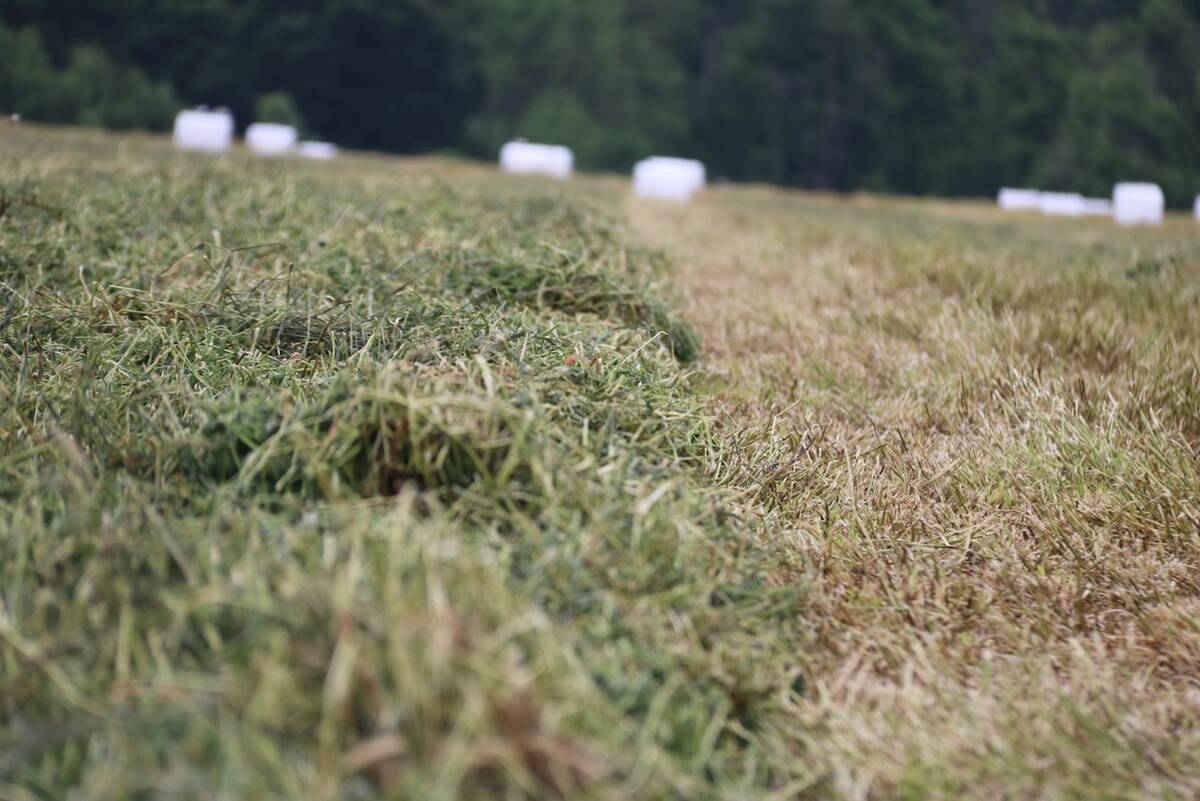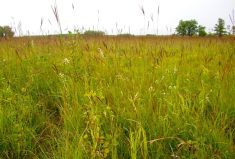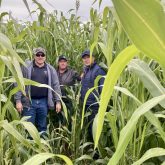The native grassland shrub, Krascheninnikovia lanata, is known as winterfat for good reason. Its protein level holds steady around 14 per cent into fall and ranges from nine to 11 per cent throughout winter, with year-long digestibility running between 55 and 65 per cent.
That’s more than enough protein to meet the seven per cent requirement for maintaining dry cows and most of the year even exceeds the 10.5 per cent requirement for lactating cows, says Dr. Mike Schellenberg, a research scientist with Agriculture and Agri-Food Canada at Swift Current.
Schellenberg, who first started evaluating winterfat’s potential in the early 2000s, sees this shrub fitting into western Canadian grazing systems as an excellent source of protein for very-early-spring grazing and extended grazing well into the fall and winter months.
The best results in one feeding trial were achieved when winterfat made up 20 to 35 per cent of the forage.
For example, Schellenberg says the protein level of western wheat grass in one study at Swift Current declined from 14.6 per cent in May to 5.5 by October and 3.7 the following February. It can drop as low as two per cent. Digestibility of western wheat grass is typically around 30 per cent or lower from fall through the winter. Providing winterfat with western wheat grass and alfalfa improved the effective digestibility percentage of western wheat grass by approximately 10 per cent.
Read Also

New high performance forage training program to launch in 2026
A new Canadian Forage and Grasslands Asssociation high performance forage program will be a resource for farmers, agronomists and others in the forage sector.
Winterfat thrives best when grazed after it has stopped growing for the season. There’s no worry about leaf loss because winterfat holds its leaves until new growth begins in the spring and the stems remain palatable throughout the winter. It is a fairly large plants, growing 18 inches high and just as wide, making it easy to find when snow is on the ground.
Old plants can reach heights of three feet and still be palatable. Schellenberg has seen cows that never ate winterfat enter a pasture not grazed in 20 years and head straight for mature winterfat patches and graze them down to nubs before moving on to the grass.
Winterfat probably got its name during those pioneer cattle drives that followed the winterfat stands from Texas to Saskatchewan. It’s also called winter sage, white sage, feather sage and sweet sage because it looks like sagebrush. To tell them apart rub the leaves. Winterfat has no sage odour.
Its strength as an “ice-cream forage,” as Schellenberg calls it, has in part been its downfall. A century of continuous preferential grazing by cattle and wildlife dramatically thinned it out, although differing lines of it can be found as far north as the Yukon and south to New Mexico.
As a plant, winterfat is well adapted to the Canadian Prairies. It withstands extreme cold, severe drought and moderate to high soil salinity, but doesn’t fare as well in high-moisture environments, or areas prone to flooding or acidic soils.
It has long taproots with fibrous roots closer to the surface and a bushy structure that traps snow for moisture, making it a valuable plant for pasture rejuvenation, erosion control and reclamation sites.
“Longevity has more to do with pasture management than anything. The key is to make sure to allow time for the plants to regrow before the next grazing,” Schellenberg stresses.
If grazed before June, plants can regrow to pre-grazing size by the end of summer. In his experience with the winterfat plots at Swift Current, removing 50 per cent of the growth in early spring actually increased vegetative growth but not seed production. Recovery will be slow when grazed any time from the beginning of June through August and in this case, the stand may need a full year of rest before the next grazing.
Establishment
He has two rules of thumb for success: sow the seed no more than one-quarter inch deep and eliminate or reduce competition from other plants before seeding.
The seed is actually a fruit covered with hairy bracts. If soaked in water you will see a small plant unfold, he explains. The tiny hairs don’t seem to bother grazing animals in the least, but can be quite irritating to people so you’ll need to wear a mask when handling the seed.
Broadcasting is recommended because the bracts prevent seed from flowing evenly through a drill. Mechanical removal of the bracts is possible, but not a great option because the process can reduce seed viability, leading to poor germination. His observation is that the bracts are nature’s way of anchoring the seed in place to aid establishment.
He recommends broadcasting your total seed mix at the rate of 300 pure live seeds per square metre (30 per square foot), followed by harrowing to just cover the seed. Packing has a negative effect on seedling emergence, likely because of damage to the seed.
Seeding is best done in late fall once the soil temperature falls below the freezing mark so the seed won’t germinate. This timing prevents the loss of seed viability that occurs under storage conditions, which can be up to 50 per cent during just one winter in storage. Early-spring seeding while moisture is sufficient for germination is an alternative. Whichever works best for you, choose a calm day because the seeds float on the wind and neighbouring annual crop growers are likely to consider winterfat a weed.
It establishes quite readily on cultivated land. If direct seeding into crop stubble, eliminate weed competition beforehand with a herbicide. When seeding directly into an existing tame forage stand, follow the recommended practice for sod seeding all forages — a herbicide application to control weeds and knock back established forages to give the new forages a window to get started.
Winterfat is a member of the goosefoot family, which is a broadleaf, therefore, avoid using broadleaf herbicides with residual soil activity, such as 2,4-D and Banvil. Glyphosate labels indicate that germination of any crop can be inhibited for 10 days after application, he adds.
The Saskatchewan Water Security Agency is presently determining beneficial management practices for establishing winterfat in existing native grassland.
As for the best seed mix, Schellenberg says it will depend on your region and intended use. He suggests sowing it with a non-aggressive grass species and a nitrogen-fixing legume to support winterfat’s high protein level.
He continues to evaluate winterfat’s productivity at differing inclusion rates in various mixtures. His findings to date are that winterfat holds it own with crested wheat grass and western wheat grass and does well with alfalfa. If the intended use is for fall and winter grazing, you may want to consider later-maturing grass and legume varieties such as Indian rice grass and native prairie clovers.
Seed availability
The good news is there will likely be a Canadian seed supplier within the next few years. Agriculture Canada has maintained a winterfat seed orchard at Swift Current and Schellenberg will be working through the registration process and a couple of smaller seed companies have expressed interest in bidding on the rights to multiply and sell the seed when the time comes.
Until then, you could try contacting native seed vendors across the Prairies listed on the Native Plant Society of Saskatchewan’s website to find out if by chance they have collected winterfat seed from the wild. As of early 2015, none identified winterfat in their offerings.
If you can’t wait to give it a try, the United States Department of Agriculture Natural Resources Conservation Service (NRCS) has just released a winterfat cultivar called “open-range,” which Schellenberg says does have viability here. He cautions producers to be wary when buying seed from other U.S. sources because most of it is collected from the wild in New Mexico and Colorado and those lines aren’t viable in northern climates.
Remember that winterfat seed quickly loses its viability in storage, so be sure to ask for a current germination test on seed from any source. The NRCS reports that germination of fresh seed can be as high as 85 to 95 per cent, but commonly drops to less than 25 per cent after three years.
Agriculture and Agri-Food Canada’s winterfat fact sheet is now available online. You can also contact Dr. Michael P. Schellenberg. Additional information is available on the NRCS website under the plant materials publications tab.


















